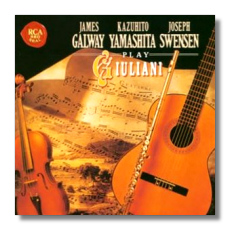
The Internet's Premier Classical Music Source
Related Links
- Giuliani Reviews
- Latest Reviews
- More Reviews
-
By Composer
-
Collections
DVD & Blu-ray
Books
Concert Reviews
Articles/Interviews
Software
Audio
Search Amazon
Recommended Links
Site News
 CD Review
CD Review
Mauro Giuliani

Chamber Music With Guitar
- Grand Duetto Concertante for Flute and Guitar
- Duo Concertant for Violin and Guitar
- Serenade for Violin, Cello and Guitar
Kazuhito Yamashita, guitar
James Galway, flute
Joseph Swensen, violin
Elizabeth Anderson, cello
RCA Red Seal 60237 65min
He may not have had the revolutionary vision of Beethoven or the melodic gift of Schubert, but Mauro Giuliani did produce a wide variety of pleasant and enjoyable music, most of which involves the guitar in one capacity or another. This release is an excellent introduction to Giuliani's gentle art.
James Galway's large, ripe, and breathy tone may strike some as a bit heavy for this relatively slight music. I wasn't at all bothered by Galway, especially since he and his partner Yamashita don't take this Grand Duetto Concertante one bit too seriously. They clearly enjoy this rare opportunity to perform together and they definitely make the most of it. Joseph Swensen effortlessly tosses off the virtuoso writing in the Duo Concertant. His tone is big, ripe, rich and juicy. Like Galway, he's clearly having a ball.
Despite Giuliani's mastery of both the guitar and the cello, it is the violin which dominates the Serenade. The opening adagio is four minutes of endless, uninspired note-spinning, but the the odd and quirky scherzo is the highlight of the disc. Unusual textures (including some eerie violin harmonics) and spicy wrong-note harmonies in the trio section will surely grab your attention. If only Giuliani had written more music in this vein. Cellist Anderson at last gets a chance to show off briefly in the lively finale. In all three works, Yamashita is a sensitive accompanist and - when called upon - an able partner.
RCA's sound is close-up with little ambience, but not so close that either the clicking of the flute's keys or the scraping of fingers on the guitar's fretboard are audible.
Copyright © 1995, Thomas Godell.
This review originally appeared in the American Record Guide


















